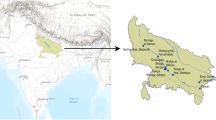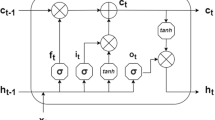Abstract
A continuous and complete spring discharge record is critical in understanding the hydrodynamic behavior of karst aquifers and the variability of freshwater resources. However, due to equipment errors, failure of observation and other reasons, missing data is a common problem for spring discharge monitoring and further hydrological investigations and data analysis. In this study, a novel approach that integrates deep learning algorithms and ensemble empirical mode decomposition (EEMD) is proposed to reconstruct the missing spring discharge data with a given local precipitation record. Using EEMD, the local precipitation data is decomposed into several intrinsic mode functions (IMFs) from high to low frequencies and a residual function, which are served as the input of convolutional neural network (CNN), long short-term memory (LSTM), and hybrid CNN-LSTM models to reconstruct the missing discharge data. Evaluation metrics, including root mean squared error (RMSE), mean absolute error (MAE), and Nash–Sutcliffe efficiency coefficient (NSE), are calculated to evaluate the reconstruction performance. The monthly spring discharge and precipitation data from March 1978 to October 2021 collected at Barton Springs in Texas are used for the validation and evaluation of newly proposed deep learning models. The results indicate that deep learning models coupled with EEMD overperform the models without EEMD and significantly improve the reconstruction results. The LSTM-EEMD model obtains the best reconstruction results among three deep learning algorithms. For models with monthly data, the missing rate affects the reconstruction performance because of the number of data samples: the best reconstruction results are achieved when the missing rate was low. If the missing rate was 50%, the reconstruction results become notably poorer. However, when the daily precipitation and discharge data are used, the models can obtain satisfactory reconstruction results with missing rate ranged from 10 to 50%.











Similar content being viewed by others
Data availability
The datasets used and analyzed during this study are available from the corresponding author on reasonable request.
References
An L, Hao Y, Yeh T-CJ et al (2020) Simulation of karst spring discharge using a combination of time–frequency analysis methods and long short-term memory neural networks. J Hydrol 589:125320. https://doi.org/10.1016/j.jhydrol.2020.125320
Bakalowicz M (2005) Karst groundwater: a challenge for new resources. Hydrogeol J 13:148–160. https://doi.org/10.1007/s10040-004-0402-9
Barzegar R, Aalami MT, Adamowski J (2021) Coupling a hybrid CNN-LSTM deep learning model with a boundary corrected maximal overlap discrete wavelet transform for multiscale lake water level forecasting. J Hydrol 598:126196. https://doi.org/10.1016/j.jhydrol.2021.126196
Chen X-W, Lin X (2014) Big data deep learning: challenges and perspectives. IEEE Access 2:514–525. https://doi.org/10.1109/ACCESS.2014.2325029
Chen X, Zhang X, Church JA et al (2017) The increasing rate of global mean sea-level rise during 1993–2014. Nature Clim Change 7:492–495. https://doi.org/10.1038/nclimate3325
Elshorbagy A, Simonovic SP, Panu US (2002) Estimation of missing streamflow data using principles of chaos theory. J Hydrol 255:123–133. https://doi.org/10.1016/S0022-1694(01)00513-3
Gao S, Huang Y, Zhang S et al (2020) Short-term runoff prediction with GRU and LSTM networks without requiring time step optimization during sample generation. J Hydrol 589:125188. https://doi.org/10.1016/j.jhydrol.2020.125188
Hartmann A, Goldscheider N, Wagener T et al (2014) Karst water resources in a changing world: review of hydrological modeling approaches. Rev Geophys 52:218–242. https://doi.org/10.1002/2013RG000443
Hauwert NM (2016) Stream recharge water balance for the Barton Springs segment of the Edwards aquifer. J Contemp Water Res Educ 159:24–49. https://doi.org/10.1111/j.1936-704X.2016.03228.x
Hochreiter S, Schmidhuber J (1997) Long short-term memory. Neural Comput 9:1735–1780. https://doi.org/10.1162/neco.1997.9.8.1735
Huang NE, Shen Z, Long SR et al (1998) The empirical mode decomposition and the Hilbert spectrum for nonlinear and non-stationary time series analysis. Proc R Soc Lond A 454:903–995. https://doi.org/10.1098/rspa.1998.0193
Hussain D, Hussain T, Khan AA et al (2020) A deep learning approach for hydrological time-series prediction: a case study of Gilgit river basin. Earth Sci Inform 13:915–927. https://doi.org/10.1007/s12145-020-00477-2
Kačaroğlu F (1999) Review of groundwater pollution and protection in karst areas. Water Air Soil Pollut 113:337–356. https://doi.org/10.1023/A:1005014532330
Kim T-Y, Cho S-B (2019) Predicting residential energy consumption using CNN-LSTM neural networks. Energy 182:72–81. https://doi.org/10.1016/j.energy.2019.05.230
Kratzert F, Klotz D, Brenner C et al (2018) Rainfall–runoff modelling using long short-term memory (LSTM) networks. Hydrol Earth Syst Sci 22:6005–6022. https://doi.org/10.5194/hess-22-6005-2018
Kumar D, Singh A, Samui P, Jha RK (2019) Forecasting monthly precipitation using sequential modelling. Hydrol Sci J 64:690–700. https://doi.org/10.1080/02626667.2019.1595624
Liu F, Cai M, Wang L, Lu Y (2019) An ensemble model based on adaptive noise reducer and over-fitting prevention LSTM for multivariate time series forecasting. IEEE Access 7:26102–26115. https://doi.org/10.1109/ACCESS.2019.2900371
Mahler BJ, Bourgeais R (2013) Dissolved oxygen fluctuations in karst spring flow and implications for endemic species: Barton Springs, Edwards aquifer, Texas, USA. J Hydrol 505:291–298. https://doi.org/10.1016/j.jhydrol.2013.10.004
Mo S, Zhu Y, Zabaras N et al (2019) Deep convolutional encoder-decoder networks for uncertainty quantification of dynamic multiphase flow in heterogeneous media. Water Resour Res 55:703–728. https://doi.org/10.1029/2018WR023528
Nourani V, Komasi M, Mano A (2009) A multivariate ANN-wavelet approach for rainfall–runoff modeling. Water Resour Manage 23:2877–2894. https://doi.org/10.1007/s11269-009-9414-5
Pan N, Feng X, Fu B et al (2018) Increasing global vegetation browning hidden in overall vegetation greening: insights from time-varying trends. Remote Sens Environ 214:59–72. https://doi.org/10.1016/j.rse.2018.05.018
Sattari M-T, Rezazadeh-Joudi A, Kusiak A (2017) Assessment of different methods for estimation of missing data in precipitation studies. Hydrol Res 48:1032–1044. https://doi.org/10.2166/nh.2016.364
Scanlon BR, Mace RE, Barrett ME, Smith B (2003) Can we simulate regional groundwater flow in a karst system using equivalent porous media models? Case study, Barton Springs Edwards aquifer, USA. J Hydrol 276:137–158. https://doi.org/10.1016/S0022-1694(03)00064-7
Shen C (2018) A transdisciplinary review of deep learning research and its relevance for water resources scientists. Water Resour Res 54:8558–8593. https://doi.org/10.1029/2018WR022643
Sit M, Demiray BZ, Xiang Z et al (2020) A comprehensive review of deep learning applications in hydrology and water resources. Water Sci Technol 82:2635–2670. https://doi.org/10.2166/wst.2020.369
Slade RM Jr, Ruiz L, Slagle D (1985) Simulation of the flow system of Barton Springs and associated Edwards aquifer in the Austin area, Texas. Water Resour Invest Rep 85:4299
Wang T, Zhang M, Yu Q, Zhang H (2012) Comparing the applications of EMD and EEMD on time–frequency analysis of seismic signal. J Appl Geophys 83:29–34. https://doi.org/10.1016/j.jappgeo.2012.05.002
Wang W, Chau K, Qiu L, Chen Y (2015) Improving forecasting accuracy of medium and long-term runoff using artificial neural network based on EEMD decomposition. Environ Res 139:46–54. https://doi.org/10.1016/j.envres.2015.02.002
Wang J-H, Lin G-F, Chang M-J et al (2019) Real-time water-level forecasting using dilated causal convolutional neural networks. Water Resour Manage 33:3759–3780. https://doi.org/10.1007/s11269-019-02342-4
Wu Z, Huang NE (2009) Ensemble empirical mode decomposition: a noise-assisted data analysis method. Adv Adapt Data Anal 01:1–41. https://doi.org/10.1142/S1793536909000047
Wu L, Kong C, Hao X, Chen W (2020) A short-term load forecasting method based on GRU-CNN hybrid neural network model. Math Probl Eng 2020:1–10. https://doi.org/10.1155/2020/1428104
Xia Y, Fabian P, Stohl A, Winterhalter M (1999) Forest climatology: estimation of missing values for Bavaria, Germany. Agric for Meteorol 96:131–144. https://doi.org/10.1016/S0168-1923(99)00056-8
Acknowledgements
The insightful comments from Dr. Marcus Schulz (Editor) and anonymous reviewers greatly improve this manuscript and are appreciated.
Author information
Authors and Affiliations
Contributions
RZ: conceptualization, resources, methodology, validation, formal analyses, and writing; YZ: methodology, review, and editing.
Corresponding author
Ethics declarations
Ethics approval
Not applicable.
Consent to participate
Not applicable.
Consent to publish
Not applicable.
Competing interests
The authors declare no competing interests.
Additional information
Responsible Editor: Marcus Schulz
Publisher's note
Springer Nature remains neutral with regard to jurisdictional claims in published maps and institutional affiliations.
Rights and permissions
About this article
Cite this article
Zhou, R., Zhang, Y. Reconstruction of missing spring discharge by using deep learning models with ensemble empirical mode decomposition of precipitation. Environ Sci Pollut Res 29, 82451–82466 (2022). https://doi.org/10.1007/s11356-022-21597-w
Received:
Accepted:
Published:
Issue Date:
DOI: https://doi.org/10.1007/s11356-022-21597-w




